These slow fermented light wheat olive oil loaves are infused with a hint of rosemary and utilize an overnight levain to ferment the dough.
This bread is similar to the prefermented light wheat olive oil rosemary loaves I made a few weeks ago; however, that version benefited from an overnight biga spiked with instant yeast, whereas these are made completely with sourdough.
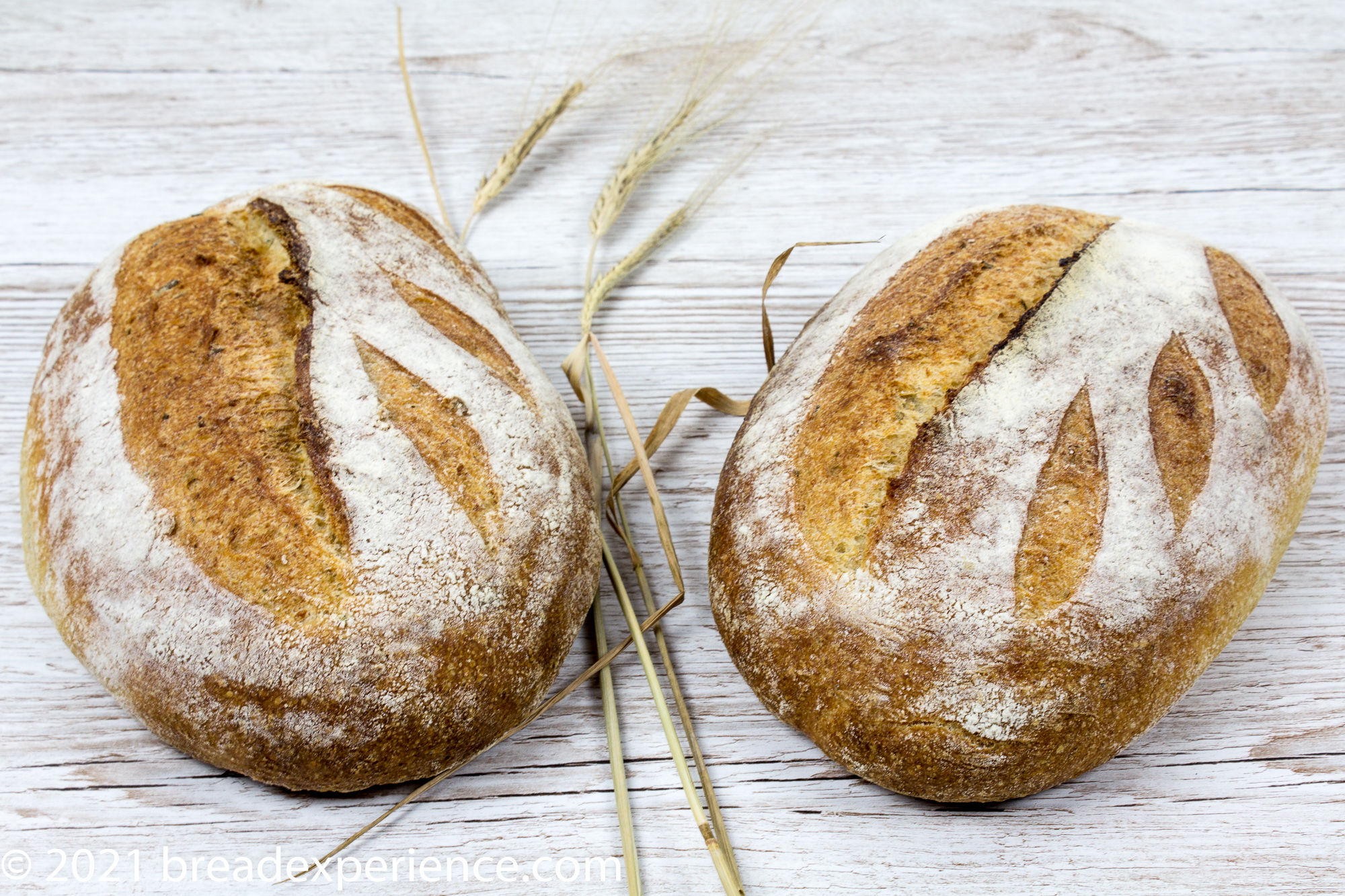
Sourdough Rosemary Olive Oil Loaves with home-milled Clark’s Cream White Wheat Flour
Why I decided to convert this bread to sourdough
In the middle of my yeasted olive oil batard experiment, and after I had made the bread several times with varying amounts of dried yeast, I watched a Bread Symposium master class with Avery Ruzicka of Manresa Bread on converting recipes made with conventional sifted white flour to freshly milled whole grains. She had some good tips that I decided to incorporate.
Converting recipes to using whole grains and ancient grains, sourdough, etc. is something I’ve been experimenting with for a while, sometimes successfully, sometimes not. Watching Avery’s method, helped me rethink my approach, at least for this bread.
Instead of continuing down the path of reducing the dried yeast and incorporating more whole grains into the dough, I opted to convert the formula to sourdough, and then start incorporating more whole grains. The main reason I did this is to be able to control the fermentation.
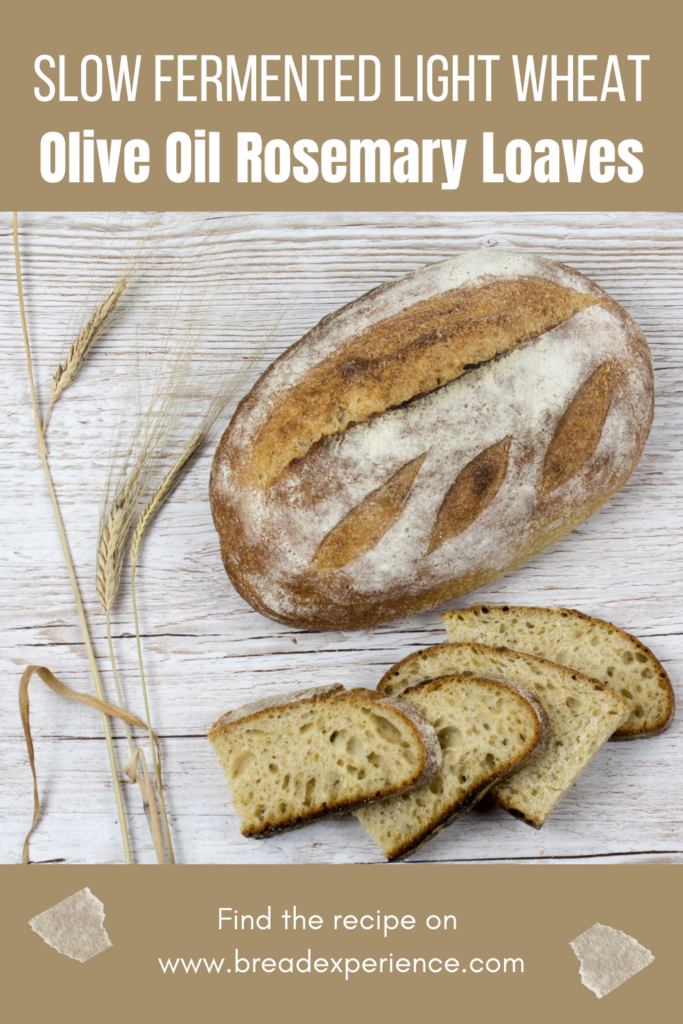
I baked this bread numerous times over several weeks. I varied the type of whole wheat grain used but kept the amount the same, 22% whole grain for each batch, including the amount used in the levain.
For the first two batches, I gave the dough a cold ferment in the refrigerator overnight. For the 3rd batch, I baked the loaves the same day the final dough was mixed.
1st Batch – Made with a portion of home-milled white winter wheat flour.
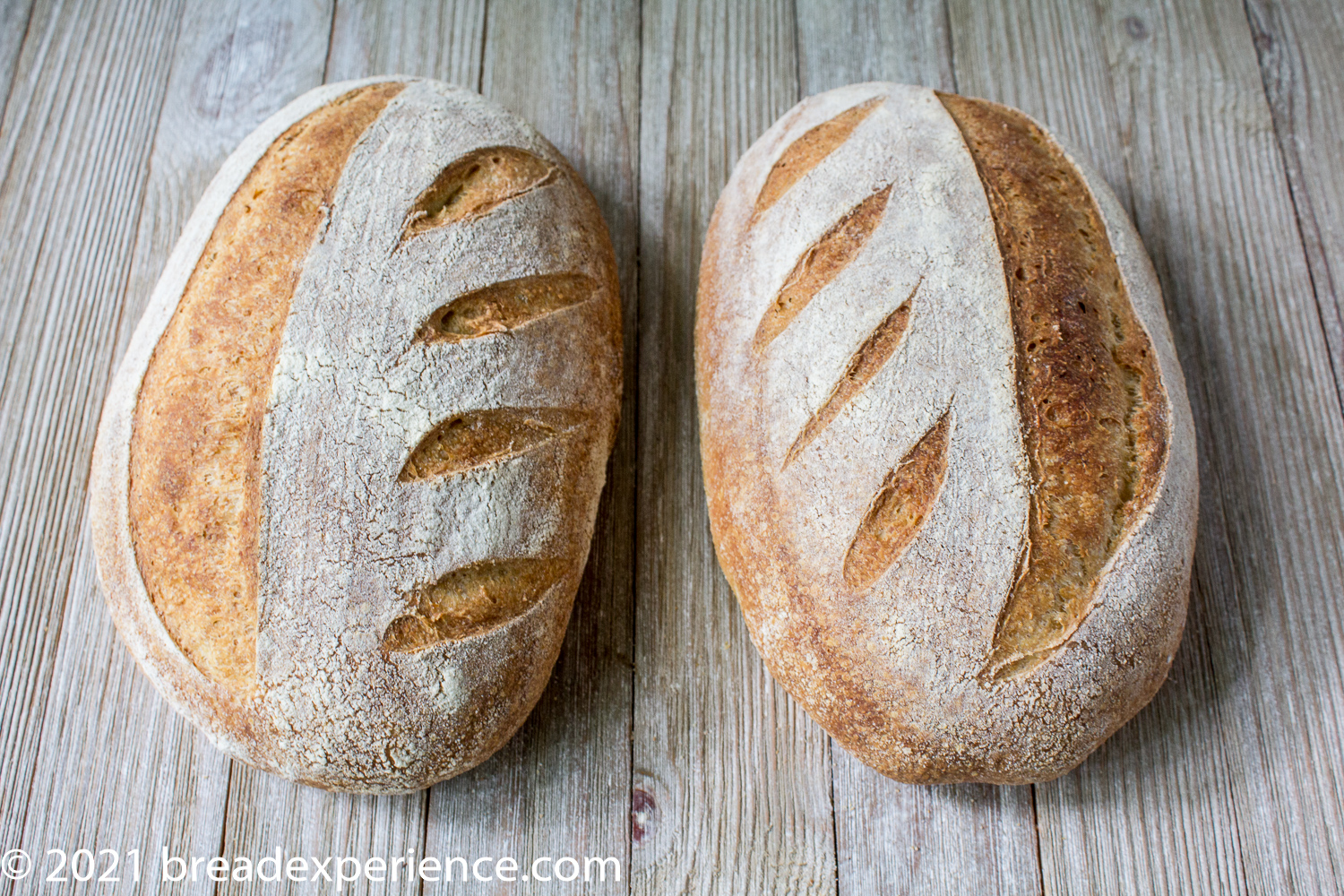
1st Bake – Proofed in baskets for 3 hours on the counter, in the refrigerator overnight, then proofed at room temperature for a couple more hours before baking. While the oven was preheating, I removed the loaves from the baskets, scored them, and left them on the counter while the oven finished preheating. They flattened a bit before baking but had pretty good over spring. The crumb structure was great. Chewy on the inside. The taste was great! The crumb shot is of the first batch. The other photos below are from the 2nd batch.
2nd Bake – Using the same levain – 2 days later. Proofed in baskets at room temperature for 3 hours as before. Placed in refrigerator overnight. Waited until after the oven was preheated to remove the baskets from the refrigerator and score the loaves. The shape of the loaves was more even. I didn’t add the rosemary to the second batch so it didn’t have the herby flavor, but the bread still tasted great.
2nd Batch – Made a week or so later using home-milled whole grain spelt as the whole grain flour. Kept the other variables the same.
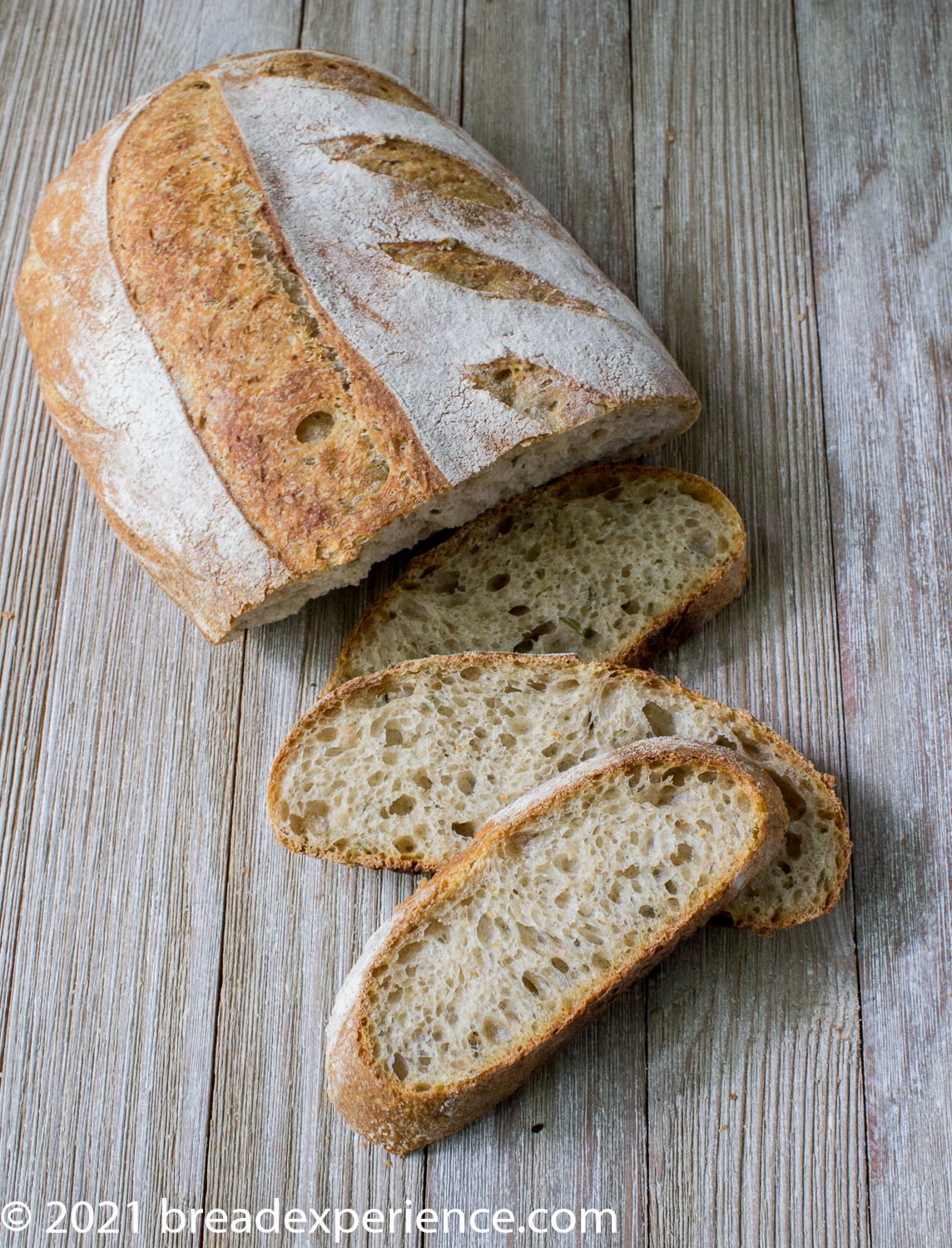
1st bake – Proofed in baskets for 3 hours on the counter, then placed in the refrigerator overnight. Removed the loaves from the refrigerator after the oven had preheated, scored and baked the loaves. One loaf was scored with a straight blade lame and the other loaf was scored with a curved blade lame.
2nd bake – Using the same levain – 2 days later. Made one round loaf instead of two batards. Proofed in basket at room temperature for 3 hours as before. Placed in refrigerator overnight. Waited until after the oven was preheated to remove the basket from the refrigerator and score the boule.
3rd Batch – Made two weeks later. Using whole wheat flour milled from Clark’s Cream white wheat. These loaves were baked the same day the final dough was prepared instead of giving the shaped loaves a cold ferment (in the bannetons) in the refrigerator overnight.
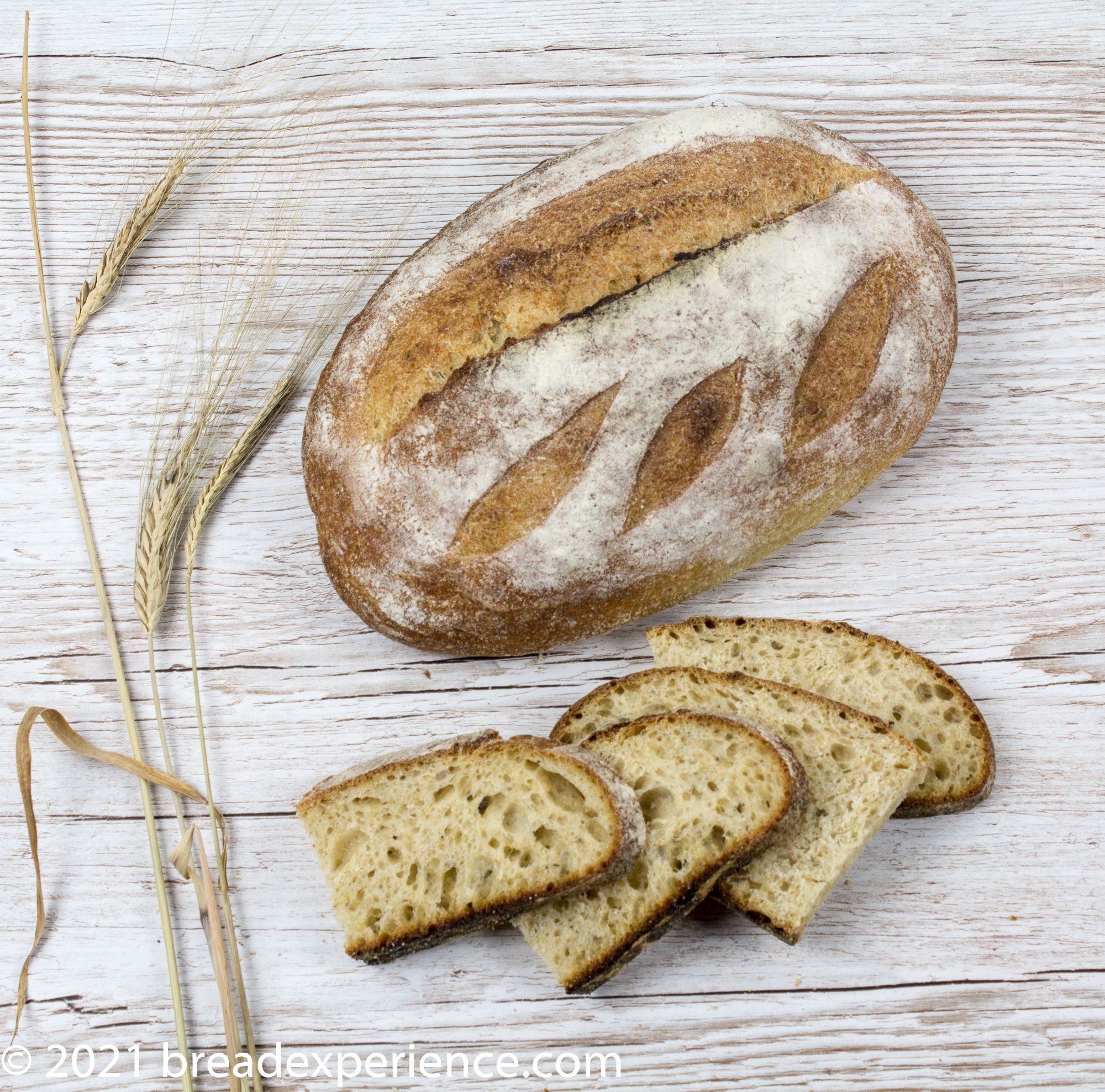
For this version, I made 3 loaves using all of the levain instead of using half of the preferment for one batch and the other half for a second batch. I shaped two batards and one round boule and scored the loaves with a straight blade lame.
This was my favorite bake! I like the color the Clark’s Cream wheat imparts to the dough.
Notes:
When I made the olive oil loaves with biga, I made two smaller loaves in two different batches. I liked the smaller loaves and having enough biga left over to make another batch in a day or so. However, with the sourdough version (3rd batch), I decided to use all of the levain and make one batch of 3 loaves. Feel free to make these loaves in batches and make two smaller loaves or one large loaf for each batch, depending on your preference.
Call me crazy, but I’ve been enjoying this bread with peanut butter and jelly. It also goes well with the pineapple jam I made earlier in the year. This bread also tastes great toasted.
Print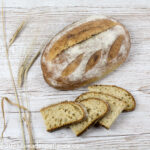
Slow Fermented Light Wheat Olive Oil Rosemary Loaves
- Yield: 3 Medium Loaves or 2 Larger Loaves 1x
Description
These slow fermented light wheat olive oil loaves are infused with a hint of rosemary and utilize an overnight levain to ferment the dough.
Ingredients
Levain
- 75 grams all-purpose flour
- 50 grams whole wheat flour
- 25 grams sourdough starter (100% hydration)
- 83 grams water
Final Dough
- 200 grams levain (all of above)
- 500 – 625 grams water (depending on coarseness of whole grain used)
- 60 grams extra virgin olive oil
- 800 grams all-purpose flour
- 200 grams whole grain flour (white winter wheat, KAMUT, spelt, etc.)
- 2–3 Tbsp. finely chopped fresh rosemary (or to taste), optional
- 28 grams fine sea salt + 25-40 grams water (as needed)
Instructions
Levain:
- In a medium bowl, whisk together the flours. Make a well in the center. Pour in the starter and mix with the water to break it up.
- Work the starter/water mixture into the flour just until no dry bits of flour remain.
- Cover, and let rest 6-8 hours in warm room temperature. If the ambient temperature in your kitchen is cooler, you may need to let it rest longer, 10-16 hours.
- At this point, the levain may be used in the final dough or placed in the refrigerator for up to 3 days.
Final Dough:
- Pour 500 grams of water and the olive oil in the bowl with the levain. Let rest while you are prepping the other ingredients. Mix to dissolve levain.
- In a large bowl, whisk together the flours and rosemary, if using. Add the levain mixture to the dry ingredients and mix thoroughly. Let rest 20-30 minutes.
- Sprinkle the salt over the dough and dissolve with 15-25 grams of water. If the dough begins to tear, add more water as needed while incorporating the salt into the dough.
- Cover and let rest in a warm place for 2-3 hours. Stretch and fold the dough after 30 minutes and again after 1 hour for a total of 2 stretch and folds. Let rest for remaining 1-2 hours.
- Turn the dough back out onto a floured work surface and deflate the dough. Divide into 3 equal pieces (650-665 grams each) for medium loaves. Total weight of dough should be between 1950-2000 grams, depending on flour used and how much water you incorporate.
- Gather up the edges and preshape the dough into a ball. Flip the ball and place it seam side down on the work surface. Push the dough against the work surface in a circular motion to tighten the top. Pull the dough toward you to elongate the dough into an oval (batard) or round (boule) shape.
- Place in rice flour-dusted and lined oval or round banneton baskets. Let proof for 2-3 hours, longer if the ambient temperature in your kitchen is cooler.
- After the final proof on the counter, the loaves can be baked immediately or placed in the refrigerator overnight for a cold ferment.
- Preheat oven to 450 degrees F. with a baking stone on the middle rack and a steam pan on the lowest shelf. I use a small cast iron skillet as my steam pan.
- Once the oven is sufficiently preheated, gently flip the loaves onto parchment paper. Brush off the excess rice flour, if desired, and dust with all-purpose flour to achieve a nice contrast when baked.
- Score the loaves in the pattern of your choice, then slide the parchment with the loaves onto the preheated baking stone. Immediately add 1 cup of ice cubes to the preheated steam pan and shut the oven door.
- Bake for 30-35 minutes. Check after 15-20 minutes and rotate the loaves for even baking. Then continue baking until nicely browned. The loaves should sound hollow when thumped on the bottom.
- Transfer loaves to a cooling rack and cool before serving.
- Category: Sourdough
Happy Baking!
Cathy
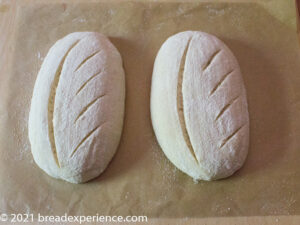
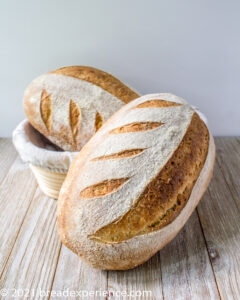
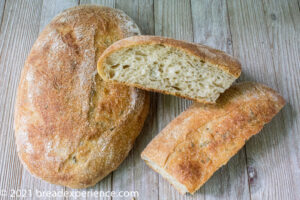
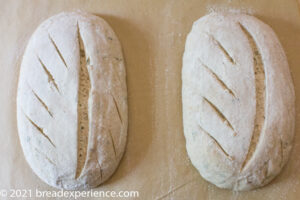
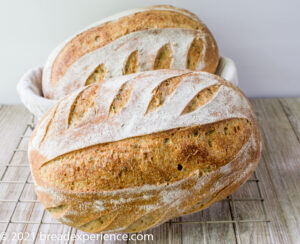
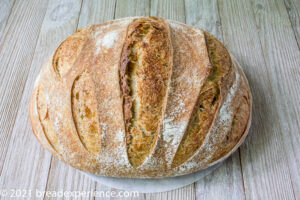
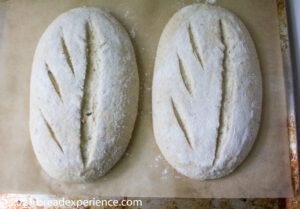
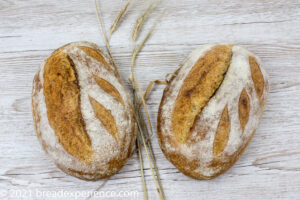
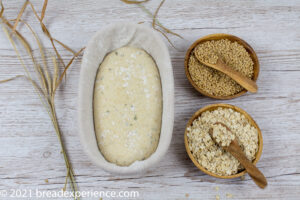
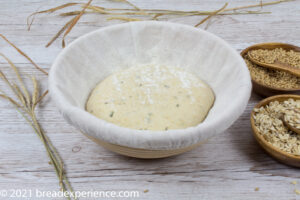
Leave a Reply